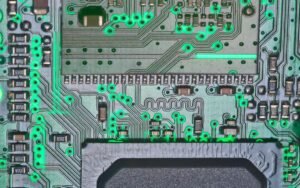AI Automation Job Loss
Artificial Intelligence (AI) and automation technologies are rapidly transforming industries and workplaces, leading to concerns about job losses. As companies adopt AI solutions to streamline processes and increase efficiency, certain tasks previously performed by humans are being automated. While this shift brings numerous benefits, it also raises questions about the impact on employment and job security.
Key Takeaways
- AI and automation technologies are revolutionizing industries.
- Increased adoption of AI leads to concerns about job losses.
- Understanding the impact of AI automation on jobs is crucial.
**Automation through AI technologies has the potential to replace various job roles across different sectors**. Routine and repetitive tasks that can be easily defined by algorithms are particularly vulnerable to automation. Administrative duties, manufacturing assembly lines, and customer service positions are some examples of roles that can be affected. According to a recent study, **47% of all jobs in the United States could be automated in the near future**.
It is important to note that **AI automation does not necessarily equate to unemployment**. While certain jobs may become redundant, new opportunities can arise. AI technologies can create new job roles that require skills in managing, monitoring, and designing AI-driven systems. Moreover, **automation can free up time for employees to focus on more complex and creative tasks** that require human intelligence and intuition.
Impact on Employment Sectors
AI automation affects various employment sectors in different ways. Here are some examples:
1. Manufacturing
In the manufacturing industry, AI-powered robots are increasingly taking over repetitive assembly tasks. This **improves productivity and lowers production costs**, but it can result in job losses for unskilled workers.
2. Customer Service
AI chatbots and virtual assistants are becoming common in customer service roles. While they can enhance efficiency by providing quick and accurate responses, **they may replace human customer service representatives**. However, these technologies still require human oversight to handle complex issues and provide personalized experiences.
3. Healthcare
In the healthcare sector, AI technologies can help diagnose diseases and analyze patient data efficiently. This **supports healthcare professionals in making informed decisions**, but it may reduce the need for certain diagnostic roles.
Data on AI Automation Job Loss
Data 1: Percentage of Jobs at Risk of Automation
| Sector | Percentage of Jobs at Risk |
|---|---|
| Transportation & Storage | 56% |
| Manufacturing | 46% |
| Retail Trade | 38% |
| Wholesale Trade | 31% |
Data 2: Job Loss Due to AI Technologies
| Country | Estimated Job Loss |
|---|---|
| United States | 5 million by 2025 |
| United Kingdom | 1.4 million by 2030 |
| Germany | 4.7 million by 2030 |
| Japan | 2.1 million by 2030 |
Data 3: Top AI Automation Job Loss Sectors in the United States
| Sector | Percentage of Jobs at Risk |
|---|---|
| Food Preparation & Serving | 73% |
| Warehouse & Logistics | 72% |
| Retail Sales | 63% |
| Office & Administrative Support | 60% |
**In order to mitigate the negative effects of AI automation on jobs**, it is essential for individuals and organizations to adapt. Upskilling and reskilling programs can help prepare employees for new roles that emerge as a result of automation. Governments and educational institutions can also play a significant role in providing support and resources for individuals whose jobs are displaced by AI technologies.
**The future of work will undoubtedly be shaped by AI and automation**, and it is important to approach this transformation with a proactive mindset. By embracing the potential of AI technologies while also preparing for the changes they bring, individuals and organizations can navigate the evolving job landscape successfully.

Common Misconceptions
1. Artificial Intelligence and Automation will replace all jobs
One common misconception about artificial intelligence (AI) and automation is that they will completely replace humans in all job roles. However, this is not entirely true. While AI and automation can automate repetitive tasks and streamline certain processes, they cannot fully replicate human creativity, emotional intelligence, and critical thinking skills that are necessary for many complex tasks.
- AI and automation can only replace specific tasks, not entire job roles
- Human judgment and decision-making are crucial in many fields that require empathy and ethical considerations
- New job opportunities arise as new technologies are introduced
2. AI and Automation will leave workers unemployed without alternatives
Another misconception is that AI and automation will lead to widespread unemployment without any alternative opportunities for displaced workers. While some jobs may be automated, new jobs that require AI skills and knowledge are emerging. Additionally, the advancement of technology often creates new industries and job roles that were not previously imagined.
- Workers can adapt and upskill to meet the demands of AI-related job roles
- New jobs will be created to develop, manage, and maintain AI systems
- Efficiency gains from AI can free up human resources for more valuable and creative tasks
3. AI and Automation will only benefit large corporations
Many believe that AI and automation technologies are only advantageous for large corporations, while the workers and smaller businesses will suffer. However, AI can also bring benefits to small businesses and individuals, enabling them to be more competitive and efficient.
- Smaller businesses can leverage AI tools for better decision-making and data analysis
- AI-powered automation can help streamline operations and reduce costs for organizations of any size
- Individuals can use AI applications to enhance productivity and simplify daily tasks
4. AI and Automation will lead to jobless societies
There is a misconception that AI and automation will eventually lead to jobless societies, where humans are no longer required for work. While it is true that some jobs may be automated, history has shown that technological advancements have consistently created new job opportunities that were not previously imagined.
- Humans will continue to be needed for creativity, innovation, and critical thinking
- New industries and job roles will emerge, requiring different skill sets
- AI and automation can complement human abilities, leading to augmentation rather than replacement
5. AI and Automation will make human workers redundant
One of the misconceptions is that AI and automation will make human workers redundant, implying that humans will no longer be valuable contributors in the workforce. However, AI is designed to assist and enhance human capabilities rather than replace them. It can handle repetitive and mundane tasks, allowing humans to focus on more complex and value-driven work.
- AI can enhance productivity and efficiency, making human workers more valuable
- Humans possess unique qualities like emotional intelligence and creativity that are challenging to replicate in AI systems
- Collaboration between AI and human workers can lead to more innovative solutions and outcomes

Introduction
AI automation has been a topic of discussion in recent years, with its potential impact on job loss being a major concern. This article delves into the various aspects of this issue, presenting ten intriguing tables that shed light on the data and facts surrounding AI automation and job loss. Each table encompasses a unique perspective that contributes to the overall understanding of this topic.
Table 1: Unemployment Rates Across Industries
Highlighting the correlation between AI automation and job loss, this table compares unemployment rates across different sectors. It reveals how industries traditionally reliant on human labor, such as manufacturing and agriculture, have experienced significant declines in employment due to automation technologies.
Table 2: Increased Productivity with AI
Examining the positive side of AI automation, this table demonstrates how companies adopting artificial intelligence in their operations witness increased productivity. It showcases real-world examples of businesses amplifying their output with automated systems, leading to growth and efficiency gains.
Table 3: Top Occupations at Risk
Delving into the specific occupations facing the highest risk of obsolescence due to AI automation, this table presents a comprehensive list. By quantifying the potential job loss in various fields, it offers insights into which professions are most susceptible and highlights the need for reskilling and upskilling initiatives.
Table 4: Roles with Least Automation Potential
Contrasting the previous table, this table enumerates occupations least likely to be affected by AI automation. By showcasing roles that require high levels of creativity, complex problem-solving, and emotional intelligence, it emphasizes the indispensability of these skills in a world driven by automation.
Table 5: Economic Opportunities Created
Although job displacement is a significant concern, this table focuses on the potential economic opportunities that arise with AI automation. It sheds light on emerging industries, such as AI development, data analytics, and robotics, which witness job growth and provide new avenues for employment.
Table 6: AI-Related Job Creation
Intricately connected to the previous table, this one exhibits the rising demand for jobs related to AI. It encompasses various roles, such as machine learning engineers, AI ethicists, and automation specialists, showcasing the promising career prospects within the AI ecosystem.
Table 7: Benefits of Workplace AI Integration
Highlighting the potential benefits of integrating AI into the workplace, this table emphasizes improved efficiency, reduced errors, and enhanced decision-making. It further illustrates the cost savings for businesses and the improved quality of products and services that AI automation can offer.
Table 8: AI Assistance in Job Enhancement
Challenging the notion of job loss, this table explores how AI can be leveraged to enhance existing job roles. Whether by automating repetitive tasks or providing valuable insights, AI support can enable employees to focus on more strategic and creative aspects of their work, fostering career development.
Table 9: Global AI Investment Trends
Unveiling the increasing pace of AI adoption worldwide, this table presents investment trends in different countries. It showcases the level of commitment and resources nations are dedicating to AI research, development, and implementation, further emphasizing the significance of this technology.
Table 10: Public Opinions on AI Automation
Lastly, this table reflects the diverse range of public opinions on AI automation and job loss. It highlights various perspectives, from concern about job displacement to anticipation of technological advancements, providing valuable insights into societal sentiments regarding this transformative era.
Conclusion
AI automation presents both challenges and opportunities in the job market. As AI continues to innovate and disrupt various industries, it is crucial to navigate these changes thoughtfully. By leveraging the insights presented in these ten engaging tables, stakeholders can develop strategies that embrace the benefits of AI while mitigating the potential negative consequences. Ultimately, the future of work lies in striking a balance between human ingenuity and technological advancements.
Frequently Asked Questions
1. How does AI automation impact job loss?
AI automation can lead to job loss as it replaces certain tasks traditionally performed by humans. The implementation of AI technology can automate repetitive and manual tasks, resulting in decreased demand for human workers in those specific areas.
2. Which industries are more susceptible to job loss due to AI automation?
Industries that heavily rely on routine and repetitive tasks, such as manufacturing, customer service, data entry, and transportation, are more susceptible to job loss due to AI automation. These industries often involve tasks that can be easily automated by AI technology.
3. Will all jobs be replaced by AI automation in the future?
Not all jobs will be replaced by AI automation in the future. While AI can automate certain tasks, there are still many jobs that require human skills such as creativity, critical thinking, and emotional intelligence. The nature of these jobs makes them less prone to automation.
4. How can workers adapt to AI automation to avoid job loss?
Workers can adapt to AI automation by acquiring new skills that are in demand in the AI-driven job market. They can focus on developing skills that complement AI technology such as problem-solving, adaptability, and complex analysis. Continuous learning and staying updated on advancements in AI can also help workers stay relevant in their fields.
5. Will AI automation create new job opportunities?
Yes, AI automation has the potential to create new job opportunities. While it may lead to job displacement in certain areas, it also opens up possibilities for new roles related to the development, maintenance, and operation of AI systems. Additionally, the increased efficiency and productivity brought by AI automation can spur economic growth and create new job sectors.
6. How will AI automation impact the overall economy?
The impact of AI automation on the overall economy is complex. While it can lead to temporary job displacements, it can also lead to increased productivity, cost savings, and innovation. The adoption of AI technology can enhance efficiency and promote economic growth. However, there is a need for proper measures to ensure a smooth transition for affected workers and to address potential economic inequalities.
7. Can AI automation lead to job augmentation instead of job loss?
Yes, AI automation can lead to job augmentation instead of job loss in many cases. The integration of AI technology can automate repetitive tasks, allowing workers to focus more on complex and creative aspects of their jobs. This shift can lead to the creation of new roles that require human skills, resulting in job augmentation rather than complete job loss.
8. How can businesses effectively implement AI automation while minimizing job loss?
Businesses can effectively implement AI automation while minimizing job loss by adopting a thoughtful approach. They can consider reskilling and upskilling their workforce to ensure a smooth transition into new roles. Effective communication and transparency with employees regarding automation plans can also help reduce uncertainty and improve overall acceptance of the changes.
9. What are the potential benefits of AI automation?
Potential benefits of AI automation include increased efficiency, cost savings, improved accuracy, and enhanced productivity. AI technology can help businesses automate routine tasks, analyze vast amounts of data, and make intelligent decisions, leading to streamlined operations and improved outcomes.
10. How can society prepare for the impact of AI automation on job loss?
Society can prepare for the impact of AI automation on job loss by fostering a culture of continuous learning and adaptability. Providing access to affordable education and training programs can empower individuals to acquire new skills and transition into emerging industries. Governments and organizations can also develop policies and initiatives that support affected workers and ensure a smooth societal transition.





